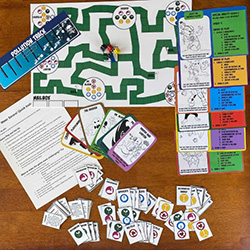 Relevancy and Engagement
dc.agclassroom.org
Relevancy and Engagement
dc.agclassroom.org

Water Savers
Water Savers is a board game developed for grades 6-12 and designed to support a group of 2-5 students. The game introduces environmental issues and sustainable farming practices to encourage understanding of issues within students' community and/or region.
Materials
- Lore Story, 1 copy per class or student group*
- Villian and Hero descriptions, digital copy to project or 1 printed copy for each group*
- Game board and pieces, 1 per group of 2-5 students:
- Water Savers Rule Sheet and Game Instructions*
- Game Board (Recommended printing on 11" x 17" paper)*
- Game Cards (Print on cardstock and cut out)*
- Hero Cards (Print front and back on cardstock and cut them out. Be sure to let the printer know the weight of the cardstock, otherwise they will not print front and back correctly)*
- Villain Cards (Print front and back on cardstock and cut them out. Be sure to let the printer know the weight of the cardstock, otherwise they will not print front and back correctly)*
- Pollution Track (Optional)
- Environmental Action Plan, (Optional) 1 copy per student group
*These items are available in the Water Savers Game, which can be purchased from agclassroomstore.com.
Procedures
- Read the Lore Story to the students or have them read it within their game playing groups.
- Organize the class into groups of 2-5 students. Give each student group a Water Savers game board and game pieces listed in the Materials section.
- Tip: Larger groups (5) will complete the game quicker and with more success than a small group of students.
- Review the Rule Sheet and Game Instructions together as a class. If needed, see the modification options below.
- Introduce students to the Villains (environmental issues) and Heroes (sustainable farming practices to help combat environmental issues) in the game.
- Instruct students to play the game. As they play, encourage students to think about how they are defeating the Villains and how it might relate to the real world. Students should also be reminded to think about how this activity connects to big ideas.
- You may use a timer for the game, or a pollution track.
- Following the game, discuss any of the following questions with students. Keep track of their answers on the board.
- What motivations did you, as the player, experience while you played the game? If you were put in your hero's shoes, do your motivators change?
- Who were the different villains? Do you think the villains live on Earth? How might these villains represent issues in our community? Could the villains represent environmental issues and/or problems?
- Could the heroes live on Earth? Do you think the heroes could be found in our community? Do they represent things near us? How might these heroes be examples of players?
- Why do you think the game designers chose to represent environmental actions through the cards like they did?
- Ask the students, "What do you already know about watersheds?" (They were mentioned in the game.)
- After listening to the students' answers, watch the What is a Watershed? video.
- Conclude by asking the students to make connections between one of the villains (environmental issues) and/or one of the heroes (sustainable farming practices) and the importance of healthy watersheds in our communities.
- Optional: Transition to the Environmental Action Plan. Give each group one copy. As a group, students work together using their knowledge gained from the game to determine ways that they could take action to help solve an environmental issue in your community. As a class, you may choose to produce an action plan for a water quality issue in your area.
- The Environmental Action Sheet may be collected to help observe student ideas and to promote action.
Modifications:
- For younger students, remove the Crisis and Event cards or lower the number of them within the deck.
- For students with prior knowledge of environmental issues, have the students create their own crisis, Hero, or Villain.
- Students can survey their neighborhood/surrounding area for farming practices that are helpful or harmful to water quality and look for areas that may have an increase in the amount of nutrients.
- Encourage students to explore what goes into their water or where their water comes from (this is a good place to also include the water cycle/nitrogen cycle).
- Expand student understanding by having them design a buffer strip, or other sustainable farming practices, that will also increase biodiversity.
Author
Organization
Sources
Upper Iowa University – Environmental Issues Instruction (EII)
This project has been funded wholly or in part by the United States Environmental Protection Agency under assistance agreement NE97783101 to Upper Iowa University. The contents of this document do not necessarily reflect the views and policies of the Environmental Protection Agency, nor does the EPA endorse trade names or recommend the use of commercial products mentioned in this document.